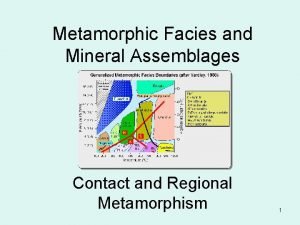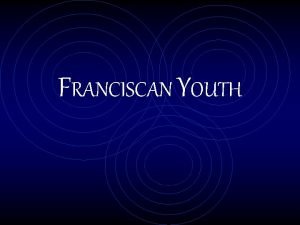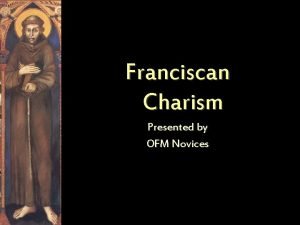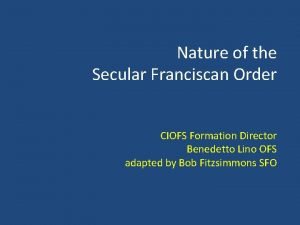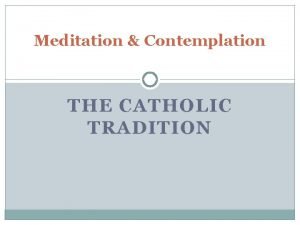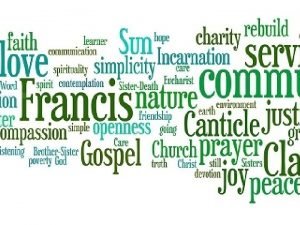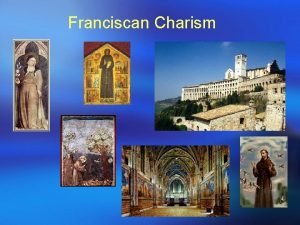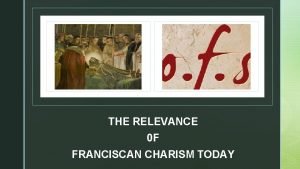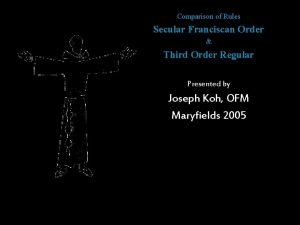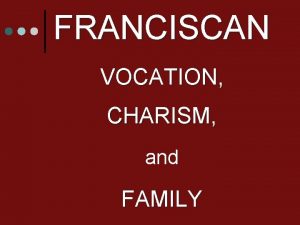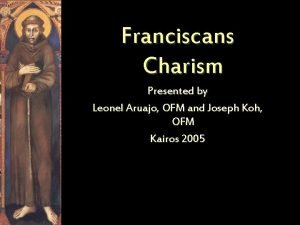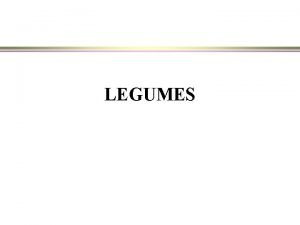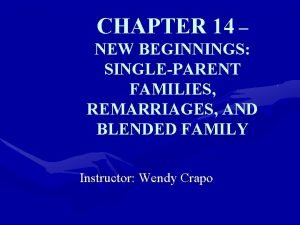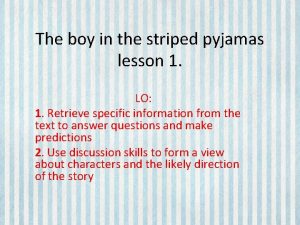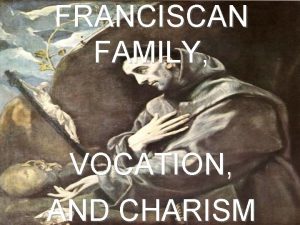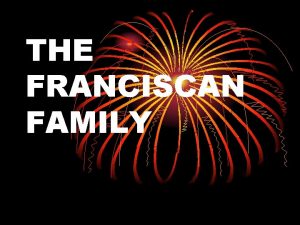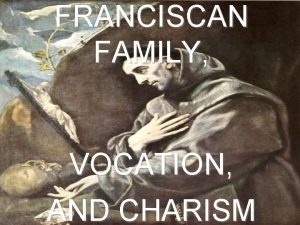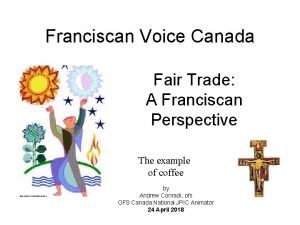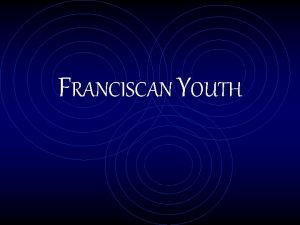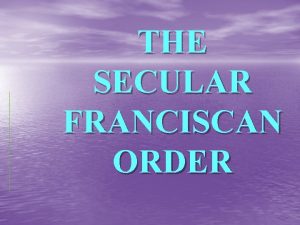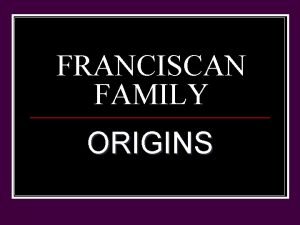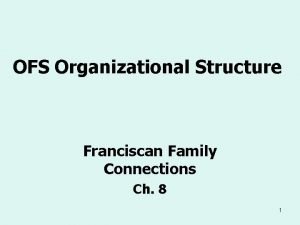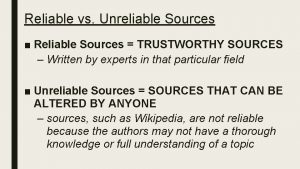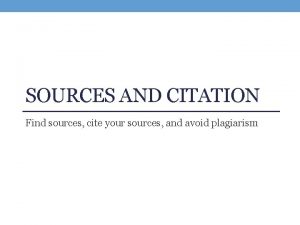The Franciscan Family From the sources u Why

































- Slides: 33

The Franciscan Family

From the sources u Why the whole world is running after Francis u Brother Masseo, one of Francis’ first brothers, was unable to understand why so many people were running after Francis. His followers came from every walk of life: young and old, men and women, educated and illiterate, married and single, noble folk and peasants alike. All wanted to walk the way of Francis. “What could it be? ” Masseo wondered. “what is it that attracts all these people? ” Francis was not an educated man; he know how to read and write, but not much else. He did not have an instantly recognizable family name, nor could he boast of a noble heritage. He was merely the son of a merchant. Nor was Francis good looking; he had lop ears, he was small and almost repulsive to look at. It was neither his education, background nor personal appearance that attracted so many people. So what was it? Brother Masseo repeated his thoughts to Francis. When Francis heard them, he rejoiced: “If none of these things matter, “ he exclaimed, “then it is God Himself who attracts them; it is because of Him that all these people follow me” (based on Fioretti 10)

Francis v He was not good looking v He was small, almost repulsive to look at v He was an uneducated man v He was merely the son of a merchant. Therefore, Brother Masseo wondered: “What is it that attracts all these people? “ v “Then it is God Himself who attracts them…“ (Francis)

A Common Vocation u u Francis and Clare committed themselves to an incarnational faith, which was made a reality by the birth of Jesus of Nazareth. That is their common vocation. They did not remain alone in their calling. God gave them countless sisters and brothers to share in it (see Test 14). But it is not enough to merely speak of our common vocation, we also have to live it and share in witnessing together to that vocation in the world. In our days, this is ever more important. As so far we have done far too little to promote our joint Franciscan calling. And we are also not united as one family.

Overview u Francis and Clare had a marvellous effect. This is not surprising since the social system in which Francis grew up was not very aware of the Gospel and the poor Jesus of Nazareth. Many people who were unhappy with the state of affairs (beguines, poverty movement, penitential movement, albigensian a. o. ) were searching for an alternative way to live. u At first, Francis had also worked out such an alternative way for himself personally, without any intention of forming an order. However, brothers were then given him (Test 14) (= First Order). Soon after that sisters were given to him as well (= Second Order). There were also people who converted in the encounter with Francis. Life of penance (= Third Order)


Origins with Francis and Clare

The Penitential Movement and the Beguines u u u Francis called his new life a “life of penance”. As a consequence the name of his fraternity was “ the penitents of Assisi“ Clare too, saw herself as a penitent. The medieval understanding of religious commitment was different in essence from our own. Since earliest Christian times, sin and forgiveness were not regarded as affecting only the individual. The public could not regard sin and reparation with indifference. The public role of defining sin, imposition of penalties and forgiveness for sins was taken on by the Church. With time, this state of affairs was forgotten; private confession was on the increase, and this not without resistance from the institutional church. However, many women and men decided to enter into a state of penance out of their own free will. In the early 13 th century, even before Francis and Clare, there was real enthusiasm for this “Order of Penitents“.

Francis‘ Alternative Way u u In his Testament Francis divides his life into two quite distinct phase: the life "in sin" and the “life of penance“. Both stood out against each other through the „Exodus from the World“. In order to understand this fascination Francis exerted on so many people, we need to examine the nature of his life "in sin“. First of all, it is meant to express a general state: a complete reliance on social values that have remained untouched by God, Christ, and the Gospel. Even if Assisi was shaped by the existence of churches, priests, and church services, most of the inhabitants were more concerned with feathering their own nests without caring of others.

Francis’ world before he withdraws from it u u u Urban development The majority of the population lives at substinence level. With the rise of the towns, a sense of urban self-confidence came about, which at the same time signified social change. This change in the structure of society was a painful process which lasted for decades. In Assisi it led to revolution, civil war, and captivity. In 1203 the „Peace Charter" was signed in Assisi between the nobility and the people of Assisi. It reaffirmed government by the nobility, but in a milder form. Directly after this (1203 -1204) many of the decisive events in Francis‘s life were to take place: his illness, his encounter with the leper, his experience in the church of San Damiano, and the rift with his father. In 1210 a „Freedom Charter", was presented in Assisi, which shifts the political weight to the advantage of the common people. At about the same time Francis – who is accompanied by eleven companions - presents his own“ Freedom Charter“ to the Pope, the Rule of Life to which the brothers had “voluntarily“ dedicated themselves (Rule of 1221).

Culture of Compassion u u Francis meets the social need of his time as it is clearly visible in the rampaged face of a leper. Francis recognized that Assisi was a „culture without compassion“ a system that is not based on Gospel values, it focuses on money and prestige, on the power of the rule of the rich over the poor. He distanced himself from this world and started a “culture of compassion“. He discovers the Gospel of the poor and set himself alongside the great number of beggars and day labourers.

The effect u u At first Francis remained alone for a while, despised, pursued by his father, declared mad. Then, however, brothers came along, and then sisters. And after 10 to 15 years vast numbers of people had been carried away by the Franciscan alternative. Two texts are to illustrate Francis effectiveness:

u “Many of the people, both noble and common, cleric and lay, impelled by divine inspiration began to come to St. Francis, wanting to do service under his discipline and leadership. The Holy Man of God watered them all with a plenteous river of heavenly grace…“ (1 Cel 36 ff. ). A great number of men and women, rich and common renounced all their possessions and left the world for the love of Christ; they call themselves Friars Minor or Sisters Minor…“ (Jacques de Vitry)

Clare of Assisi u u The second founding figure who adopts this new spiritual outlook right from the beginning is Clare of Assisi. She has a clear sense of her own spirituality, even before she meets Francis. Clare belonged to the “majores“, the noble class; Francis was a member of the “minores“, although he was the son of a merchant. For these Sisters Minor, as they were initially known, for The Poor Ladies of San Damiano, as they were then called officially, Francis wrote a Rule of Life. Clare adopted it into the text of her own Rule. Until this time this type of life was unknown in the Church and asked for a different kind of lifestyle. After a life-long fight with the Roman Curia Clare finally achieved her ideal to live the Franciscan way of life. She produced her own Rule – as the first woman in Church history.

The Three Orders u u u Initially Francis and Clare an integral part of a wider penitential movement. However, their personalities are so strong that they differ from the initial position and they develop their own paths. Out of their appeal to others emerged three orders. It is a many-faceted community of people who wanted to share the alternative way offered by Francis and who had found their personal identity, a meaning for their lives, and their individual profile in the encounter with Francis.

The Franciscan Third Order u u u u If we take the penitential movement to be the starting point for Francis and Clare, there is a direct line of development to the Franciscan Penitents‘ Order, as the Third Order was originally called. Most likely Greccio had been the place where the Third Order of Saint Francis had its origins. Francis gave these people a kind of Rule, the „Letter to the Faithful". It contains spiritual principles and concrete guidelines. The Memoriale – which had not been written by Francis – contains the exhortation to refuse military service. In 1289 the Memoriale is superseded by the Rule of Nicholas IV Historically, the Third Order has taken on many forms.

u u u u The original form – the “Converted in their own homes“. The “Recluses“ – men and women, whose life of penance led them to shut themselves up in towers or city walls. The Sisterhoods – women, who got together to live a communal life. The Regular Men‘s Order – men who adopted the Rule of the Third Order, but aligned themselves with the First Order. Congregations – women who partnered up to take on social tasks. The Third Order Regular – 382 female and 22 male congregations and institutes are united by a common Rule. This Rule was ratified by Pope John Paul II in 1982. The Secular Franciscan Order – originally of enormous sociopolitical importance the Order of Penitents gradually turned into a pious order. Today the focus is again on its original form and function.

The First Order: The Order of Friars Minor (OFM) u This Order, with the largest membership of the three Orders, is generally known to the public as the Franciscans, brown Franciscans, Observants, Bernardines etc. In 1517 the Order was separated from the Conventuals. The new groupings of the OFM, which emerged, were once again united by Pope Leo XIII. (Leonine Union).

OFMConv = Order of Friars Minor Conventual u u This numerically smallest Order also has a different name: Minorites, black Franciscans Nowadays it is present on all five continents.

OFMCap = Order of Friars Minor Capuchin u u Between 1521 -1528, through a process of change, the community of the Capuchins, who were originally to be a contemplative community, emerged from the OFM. Soon after, however, they re-established in public life, even in politics. Such departures and splits in the three Orders have occurred repeatedly – even till today. It should be stated at this point that this history of reforms also had an effect on the women‘s communities and on the Third Order. The affiliation to one of these movements is called "Obedience". Especially the Third Order has established its independence from the individual Orders in the past decades and has decided to become autonomous.

The Second Order: The Poor Clares (OSC) u u In 1263 Pope Urban IV declared that all „Poor Ladies of San Damiano", that is to say all sisters who looked to Clare, should be known as “Poor Clares“. 1216 Clare formulated the so-called “Privilege of Poverty", which she later asked to have ratified by the Popes. The life of the Poor Clares was similar to that of the brothers who lived in hermitages. The focus was unmistakably placed on lasting commitment to God – through prayer, by serving the Church, and in contemplation. In 1247 Innocence IV. wrote a new Rule for the Poor Clare. But he was also mistaken: by wanting to force possessions on the monasteries, he made Clare clearly offer resistance. She began to formulate her own Rule. She adopted the Rule of the Order of the Friars Minor of 1223 and thus emphasized the spiritual unity of the First and Second Order. Today this Rule applies to the majority of the convents of the Poor Clares.

Two separate types of Poor Clares u u u Damianites: Their basis is the Rule of Saint Clare (1253). The majority of convents of the Poor Clares follow this rule today (a total of about 570). Urbanites: Poor Clares who follow the Rule of Pope Urban IV (1263) (about 80 communities altogether). Behind the difference in name there is a relatively high degree of reality. Basically, each convent independent of the others. Convents under the same Rule form loose federations. Reform movements and obedience's still are of significance. New forms are also established: Poor Clares who live like a hermit within in Clare‘s Rule.

Today‘s diversity

The Franciscan Family u u u Altogethere is a great number of communities drawing their inspiration from Francis and Clare. According to the sources, already mentioned above, Francis and Clare understood the three Orders as one common, although multi-faceted, family. Today, among the different groupings of the Franciscan Family the awareness of a common bond has grown. There is a sense of belonging to a family that has to dependent on one another. This new awareness finds concrete expression in the reworking of the constitutions of the different branches (see Lesson Unit 3).

Features of the Franciscan Family To be a Sister / To be a Brother We are one “Family” In a cosmic dimension Reverence and respect for every human being and all creatures

Minority u To serve rather than to reign u Endearment instead of authority u Affection instead of distant intellectuality u Option for the cause of the “little people” (“menores”) – the impoverished and the deprived

Dimension of the simple people and the world u. A culture of the simple people instead of the “elites” u To let oneself in for the world instead of “escaping from the world” u Popular Franciscanism within the “Church of the Poor”

The Gender Dimension The human constellation is female - male The founding charism Clare – Francis

The socio-political dimension The Franciscan-Clarean spirituality is a Gospel-based alternative for people to live together.

The clerical dimension A specific kind of Church : § § § Fundamental equality Joint responsibility Democratic and common “Round table” instead of “pyramid” Subsidiarity and decentralization


Questions for Group Discussions 1. What constitutes a family? What prerequisites, attributes, and attitudes are required to be successful in the constitution of a family? 2. Do the features of a family also apply for the Franciscan Family? 3. If so, where and how do we show that we are a family – on regional, continental and global level? What remains to be done to come closer to this ideal? Please specify steps and visions as precisely as possible!

Powerpoint Presentation Revised and adapted by Fr. Andreas Müller OFM CCFMC Center Wuerzburg, Germany 2010
 Pictures
Pictures Print and web sources
Print and web sources Water resources importance
Water resources importance Franciscan supplement liturgy of the hours
Franciscan supplement liturgy of the hours Parent rock
Parent rock Secular franciscan constitution
Secular franciscan constitution Franciscan charism
Franciscan charism Chi franciscan scheduling
Chi franciscan scheduling Secular franciscan order formation
Secular franciscan order formation Contemplation vs meditation catholic
Contemplation vs meditation catholic Four pillars of franciscan spirituality
Four pillars of franciscan spirituality Franciscan charism
Franciscan charism Franciscan hospice and palliative care
Franciscan hospice and palliative care Franciscans charism
Franciscans charism Franciscan third order regular
Franciscan third order regular Franciscan secular institute
Franciscan secular institute Franciscan vocation
Franciscan vocation Franciscan charism
Franciscan charism Netclassroom padua franciscan
Netclassroom padua franciscan Don't ask why why why
Don't ask why why why Legume
Legume Conjugal family
Conjugal family Periodic table families
Periodic table families Characteristics of single parent family
Characteristics of single parent family Why did bruno's family suddenly moved house
Why did bruno's family suddenly moved house Why is there a quarrel in marietta's family
Why is there a quarrel in marietta's family Hát kết hợp bộ gõ cơ thể
Hát kết hợp bộ gõ cơ thể Bổ thể
Bổ thể Tỉ lệ cơ thể trẻ em
Tỉ lệ cơ thể trẻ em Gấu đi như thế nào
Gấu đi như thế nào Tư thế worm breton
Tư thế worm breton Hát lên người ơi alleluia
Hát lên người ơi alleluia Môn thể thao bắt đầu bằng chữ f
Môn thể thao bắt đầu bằng chữ f




